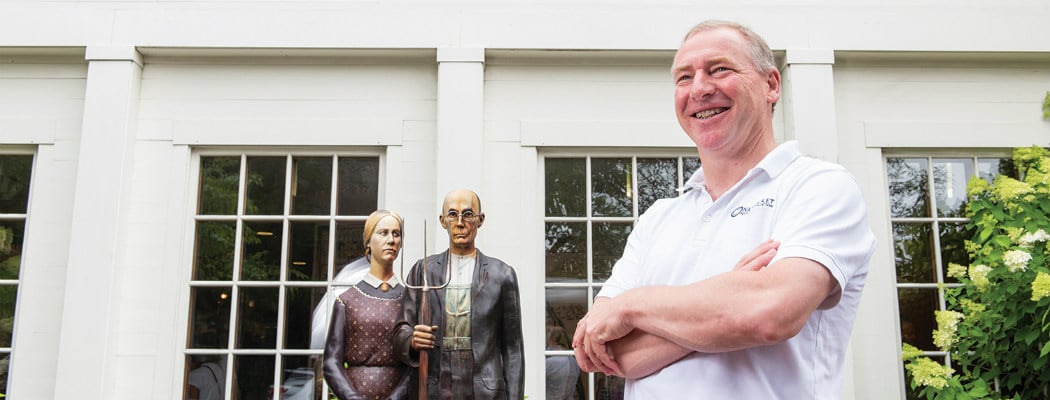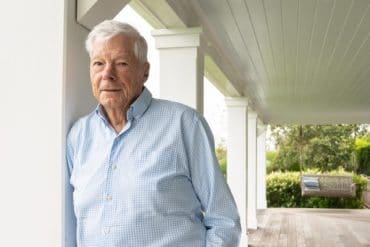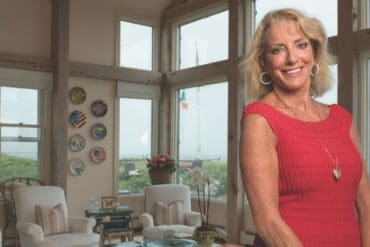How James Russell and his team at the NHA are breathing new life into the Whaling Museum.
 Bounding through the Nantucket Whaling Museum, James Russell points like a kid in a candy store at new interactive touchscreens, new works of art, new exhibits—even a new whale jaw. There are more model ships, more scrimshaw, more exhibits, more tours—more everything, really. “In six months, we have probably doubled the number of items on view here,” Russell says giddily. Hundreds of objects have been dug out of the NHA’s mid-island storage facility and put on display. Indeed, around every turn, the wave of energy that Russell and his team have brought to the museum feels nothing short of historic.
Bounding through the Nantucket Whaling Museum, James Russell points like a kid in a candy store at new interactive touchscreens, new works of art, new exhibits—even a new whale jaw. There are more model ships, more scrimshaw, more exhibits, more tours—more everything, really. “In six months, we have probably doubled the number of items on view here,” Russell says giddily. Hundreds of objects have been dug out of the NHA’s mid-island storage facility and put on display. Indeed, around every turn, the wave of energy that Russell and his team have brought to the museum feels nothing short of historic.
More than a hundred thousand annual visitors are now experiencing an entirely different Whaling Museum from a decade ago—or even a year ago. Russell’s dramatic overhaul of artifacts, exhibitions and programming at the museum and other Nantucket Historical Association (NHA) properties is putting storytelling front and center. “It’s the depth of these stories and the potential to tell them that drove me to here,” says Russell, who took over as the NHA’s Gosnell Executive Director in 2017 after serving as the president and CEO of the New Bedford Whaling Museum for nearly a decade. “With the richness of properties and interior spaces, and the history that goes well beyond whaling—there’s tremendous opportunity here now.”
 Russell and his team have put a new emphasis on making history a hands-on experience at the Whaling Museum. In the Hadwen & Barney Oil and Candle Factory, for instance, burlap sacks and bottles of translucent amber oil give visitors a more visceral sense of the large iron screw press used to squeeze the oil from the sperm whale. “We’re also using digital technology to tell more of the story,” Russell explains. “And there are some pretty interesting graphic illustrations which help put the press in context.” Meanwhile, in Gosnell Hall, French lithographs capture the drama of the whale hunt near a new life-size representation of the sailing craft Edward Cary. (Again, interactive touchscreens have been added to provide visitors with access to more context and archival images.) Inside the refurbished children’s rooms, renamed the Discovery Center, a model railway, which had been covered up for the better part of a decade, will once again chug around its track.
Russell and his team have put a new emphasis on making history a hands-on experience at the Whaling Museum. In the Hadwen & Barney Oil and Candle Factory, for instance, burlap sacks and bottles of translucent amber oil give visitors a more visceral sense of the large iron screw press used to squeeze the oil from the sperm whale. “We’re also using digital technology to tell more of the story,” Russell explains. “And there are some pretty interesting graphic illustrations which help put the press in context.” Meanwhile, in Gosnell Hall, French lithographs capture the drama of the whale hunt near a new life-size representation of the sailing craft Edward Cary. (Again, interactive touchscreens have been added to provide visitors with access to more context and archival images.) Inside the refurbished children’s rooms, renamed the Discovery Center, a model railway, which had been covered up for the better part of a decade, will once again chug around its track.
Russell looked at the footprint of the building itself and reimagined its use. With a renewed emphasis on artwork, he transformed administrative offices into a dramatic new gallery featuring thirty paintings that span the last two hundred years on Nantucket. “One effective way to talk about the post-whaling era,” Russell notes, “is through art.” Upstairs from the new Williams Forsyth Gallery is a traveling exhibition from the Smithsonian featuring a collection of modern American realist paintings from the Sara Roby Foundation. Marking the first time Nantucket has hosted an exhibition from the Smithsonian, Russell considers the exhibit a significant accomplishment that will open the doors for more world-renowned exhibits to come to Nantucket in the future.
“Our collaborations and partnerships with peer institutions have gone up dramatically,” Russell says. “We now have collaborations and partnerships with fifty-plus entities.” Examples of these collaborations can be seen in an architectural exhibit at the Hadwen House curated by Michael May of the Nantucket Preservation Trust; exhibits on whale ecology with the Marine Mammal Alliance and the Center for Coastal Studies in Provincetown, Massachusetts; and the “Strangers to Neighbors” exhibit, exploring Jewish history on Nantucket with the Congregation Shirat HaYam.
 Yet perhaps the most conspicuous collaboration is with the Artists Association of Nantucket (AAN), featuring the iconic work of one of the island’s most cherished artists, Seward Johnson. Ten of Johnson’s life-size statues are on display directly outside of the Whaling Museum as well as at various NHA properties throughout town. While the famed artist has been a lifelong summer resident, he’s never had a full exhibit on Nantucket until now. Paula Stoeke, the curator and director of exhibitions for the Seward Johnson Atelier in Santa Monica, California, worked with the NHA and AAN in picking the various works that are on display until Columbus Day, October 14th.
Yet perhaps the most conspicuous collaboration is with the Artists Association of Nantucket (AAN), featuring the iconic work of one of the island’s most cherished artists, Seward Johnson. Ten of Johnson’s life-size statues are on display directly outside of the Whaling Museum as well as at various NHA properties throughout town. While the famed artist has been a lifelong summer resident, he’s never had a full exhibit on Nantucket until now. Paula Stoeke, the curator and director of exhibitions for the Seward Johnson Atelier in Santa Monica, California, worked with the NHA and AAN in picking the various works that are on display until Columbus Day, October 14th.
“The element of interaction with Seward Johnson sculptures is crucial to his point in making his art,” Stoeke says. “He has a great sense of humor and truly enjoys surprising people by the realism in his sculptures.”
 Hundreds of visitors have taken selfies with the statues outside the Whaling Museum’s doors and around town. The sculptures include the stern American Gothic couple, a young man eating ice cream across the street from the Juice Bar and the debut of a new, never-before-seen piece of Einstein riding a bicycle. Standing guard outside of the museum, the sculptures signal an undeniable sea change at the historic institution.
Hundreds of visitors have taken selfies with the statues outside the Whaling Museum’s doors and around town. The sculptures include the stern American Gothic couple, a young man eating ice cream across the street from the Juice Bar and the debut of a new, never-before-seen piece of Einstein riding a bicycle. Standing guard outside of the museum, the sculptures signal an undeniable sea change at the historic institution.
When James Russell took over the Whaling Museum two years ago, he was bursting at the seams with big ideas to make this historic space feel new again. One need not walk far inside—or outside the museum, for that matter—to realize that he’s made good on that vision.
This year is significant in terms of local history. The Nantucket Historical Association is celebrating its 125th anniversary. Herman Melville would have turned 200 years old this past August. The first settlers arrived from the mainland 360 years ago. But 2019 might also be remembered as the year the Nantucket Historical Association began writing a new chapter in its history, one that celebrates the past while keeping an eye to the future.






